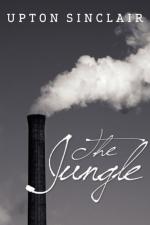The visitors were taken there and shown them, all neatly hung in rows, labeled conspicuously with the tags of the government inspectors—and some, which had been killed by a special process, marked with the sign of the kosher rabbi, certifying that it was fit for sale to the orthodox. And then the visitors were taken to the other parts of the building, to see what became of each particle of the waste material that had vanished through the floor; and to the pickling rooms, and the salting rooms, the canning rooms, and the packing rooms, where choice meat was prepared for shipping in refrigerator cars, destined to be eaten in all the four corners of civilization. Afterward they went outside, wandering about among the mazes of buildings in which was done the work auxiliary to this great industry. There was scarcely a thing needed in the business that Durham and Company did not make for themselves. There was a great steam power plant and an electricity plant. There was a barrel factory, and a boiler-repair shop. There was a building to which the grease was piped, and made into soap and lard; and then there was a factory for making lard cans, and another for making soap boxes. There was a building in which the bristles were cleaned and dried, for the making of hair cushions and such things; there was a building where the skins were dried and tanned, there was another where heads and feet were made into glue, and another where bones were made into fertilizer. No tiniest particle of organic matter was wasted in Durham’s. Out of the horns of the cattle they made combs, buttons, hairpins, and imitation ivory; out of the shinbones and other big bones they cut knife and toothbrush handles, and mouthpieces for pipes; out of the hoofs they cut hairpins and buttons, before they made the rest into glue. From such things as feet, knuckles, hide clippings, and sinews came such strange and unlikely products as gelatin, isinglass, and phosphorus, bone black, shoe blacking, and bone oil. They had curled-hair works for the cattle tails, and a “wool pullery” for the sheepskins; they made pepsin from the stomachs of the pigs, and albumen from the blood, and violin strings from the ill-smelling entrails. When there was nothing else to be done with a thing, they first put it into a tank and got out of it all the tallow and grease, and then they made it into fertilizer. All these industries were gathered into buildings near by, connected by galleries and railroads with the main establishment; and it was estimated that they had handled nearly a quarter of a billion of animals since the founding of the plant by the elder Durham a generation and more ago. If you counted with it the other big plants—and they were now really all one—it was, so Jokubas informed them, the greatest aggregation of labor and capital ever gathered in one place. It employed thirty thousand men; it supported directly two hundred and fifty thousand people in its neighborhood, and indirectly it supported half a million. It sent its products to every country in the civilized world, and it furnished the food for no less than thirty million people!




